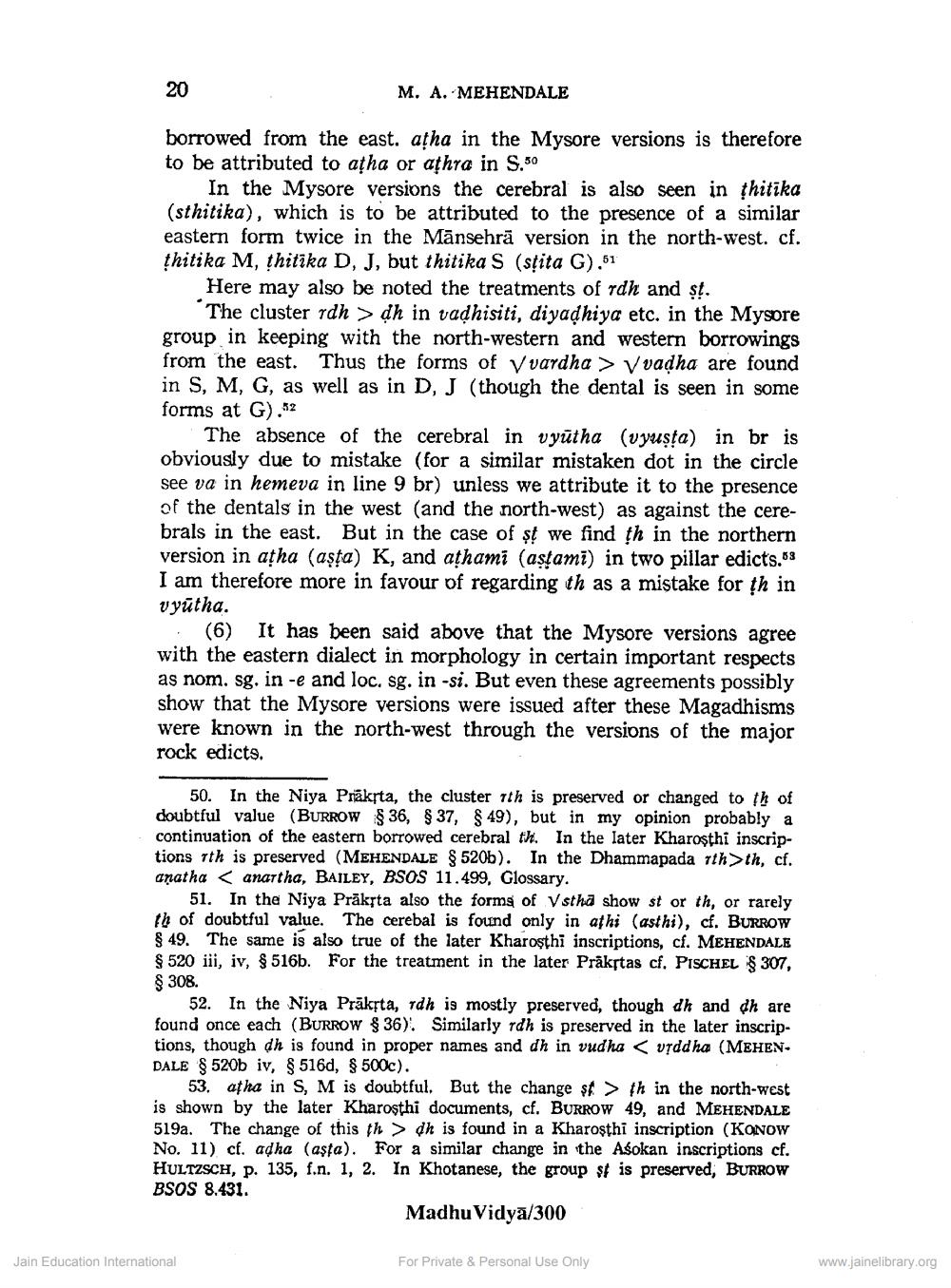________________
20
M. A. MEHENDALE
borrowed from the east. atha in the Mysore versions is therefore to be attributed to atha or athra in S.50
In the Mysore versions the cerebral is also seen in thitika (sthitika), which is to be attributed to the presence of a similar eastern form twice in the Mānsehrā version in the north-west. cf. thitika M, thitika D, J, but thitika S (sțita G).51
Here may also be noted the treatments of Tdh and st.
The cluster rdh > dh in vadhisiti, diyadhiya etc. in the Mysore group in keeping with the north-western and western borrowings from the east. Thus the forms of V vardha > Vvadha are found in S, M, G, as well as in D, J (though the dental is seen in some forms at G).52
The absence of the cerebral in vyūtha (vyusta) in bris obviously due to mistake (for a similar mistaken dot in the circle see va in hemeva in line 9 br) unless we attribute it to the presence of the dentals in the west (and the north-west) as against the cerebrals in the east. But in the case of șt we find th in the northern version in atha (aşta) K, and athami (astami) in two pillar edicts. I am therefore more in favour of regarding th as a mistake for th in vyūtha.
(6) It has been said above that the Mysore versions agree with the eastern dialect in morphology in certain important respects as nom. sg. in -e and loc, sg. in -si. But even these agreements possibly show that the Mysore versions were issued after these Magadhisms were known in the north-west through the versions of the major rock edicts.
50. In the Niya Prākrta, the cluster tth is preserved or changed to th of doubtful value (BURROW $ 36, 37, 8 49), but in my opinion probably a continuation of the eastern borrowed cerebral th. In the later Kharoşthi inscriptions oth is preserved (MEHENDALE 8 520b). In the Dhammapada 7th>th, cf. anatha < anartha, BAILEY, BSOS 11.499, Glossary.
51. In the Niya Prāksta also the forms of V stha show st or th, or rarely th of doubtful value. The cerebal is found only in athi (asthi), cf. BURROW $ 49. The same is also true of the later Kharoşthi inscriptions, cf. MEHENDALE $ 520 iii, iv, $ 516b. For the treatment in the later Pråkstas cf. PISCHEL § 307, $ 308.
52. In the Niya Prākta, rdh is mostly preserved, though dh and dh are found once each (BURROW $36). Similarly rdh is preserved in the later inscriptions, though dh is found in proper names and dh in vudha < vyddha (MEHEN. DALE $ 520b iv, $ 516d, $ 500c).
53. atha in S, M is doubtful. But the change s# > th in the north-west is shown by the later Kharosthi documents, cf. BURROW 49, and MEHENDALE 519a. The change of this th> dh is found in a Kharosthi inscription (KONOW No. 11). cf. adha (asta). For a similar change in the Asokan inscriptions cf. HULTZSCH, p. 135, f.n. 1, 2. In Khotanese, the group st is preserved, BURROW BSOS 8.431.
Madhu Vidya/300
Jain Education International
For Private & Personal Use Only
www.jainelibrary.org




